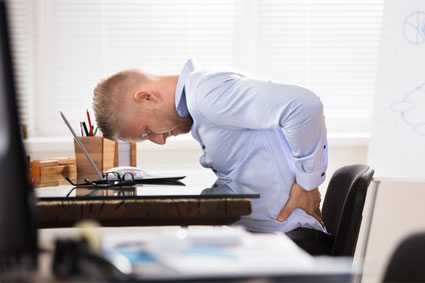
Desk Jockeys
 Today, the majority of time at work is spent sitting. Whether seated at a desk, computer, or in a car, the strain placed on the body can be equal to or greater than manual labor jobs. The human body was meant for movement; sitting for prolonged periods of time places repetitive strain on the body, leading to dysfunction and pain. If you think you are suffering from a sitting-related pain or injury, contact our experienced Woodbury chiropractors at MN Spine and Sports to inquire about treatment.
Today, the majority of time at work is spent sitting. Whether seated at a desk, computer, or in a car, the strain placed on the body can be equal to or greater than manual labor jobs. The human body was meant for movement; sitting for prolonged periods of time places repetitive strain on the body, leading to dysfunction and pain. If you think you are suffering from a sitting-related pain or injury, contact our experienced Woodbury chiropractors at MN Spine and Sports to inquire about treatment.
Are we De-evolving?
The reality of sitting over a long period of time is that the human body becomes de-conditioned. “De-conditioned Syndrome” is a by-product of a sedentary lifestyle combined with a job that requires minimal physical activity. When our lifestyle or job lacks physical activity, our postural muscles become over-used/tight and our prime mover muscles become under-used/weak. Over time, this causes significant muscular imbalances, joint restrictions and repetitive strain on certain structures. The actual sitting becomes an over-use injury, which causes the muscles or become tight and weak, creating a cycle of injury.
Two common syndromes we see amongst desk/computer workers are Anterior Head Carriage and Upper Crossed Syndrome. Anterior Head Carriage, also known as forward head carriage, is a postural fault or tendency the body exhibits because of upper cross syndrome. Simply put, it’s when the head is held in a much more forward position than it is supposed to be, causing repetitive strain, pain and further dysfunction.
How to Self-Evaluate for Anterior Head Carriage
The easiest way to tell if someone has anterior head carriage is to stand normally while drawing an imaginary line from the top of their head down through the middle point of their ankles. If the person has a proper standing posture, the line should go through the middle of their ear and the middle of their shoulder. If their ear is in front of their shoulder, they have anterior head carriage. You will realize that given the normal American lifestyle of sitting in front of computers, that many people have anterior head carriage. In no way is this a diagnosis and any symptoms related to this should be evaluated by a doctor.
Problems with Anterior Head Carriage
Because it is an abnormal body position, anterior head carriage can cause several symptoms, including headaches, neck pain, upper back pain, tight muscles, trigger points, muscles aches, and decreased range of motion. Aside from poor posture, anterior carriage can also be caused by joint restrictions in the neck and mid-back. If joint restrictions exist, flexing the neck forward decreases pressure placed on the posterior joints (facet joints) which could be an unconscious attempt for the body to alleviate symptoms or pain. The increased flexion only causes more work on the muscles in the back of the neck, increasing the symptoms associated with anterior head carriage.
Upper crossed syndrome, also known as “student syndrome” or “corporate syndrome,” is a pattern of tight and weak muscles the body develops based on one’s postural tendencies. The most common trait for someone with upper crossed syndrome is tight upper traps (a muscle in between the edge of your shoulder and your neck) and sometimes right at the posterior base of your skull. This is a very common occurrence in today’s population. The people this affects the most are those that sit all day, usually in front of a computer or at a desk. Due to poor ergonomics, most people in these situations either find themselves leaning over a desk to read, or hunched over at a computer, typing all day. In order to maintain this unnatural position, the body must continually contract certain muscles.
The muscles most likely to be tight with upper crossed include:
- Upper Trapezius/Levator Scapulae
- Deep neck extensors
- Chest/Anterior Shoulders
- Sub-occipital muscles (behind the head, where the neck meets)
The muscles that tend to be weak or lengthened include:
- Mid-back musculature
- Deep neck flexors
